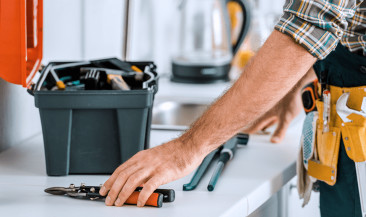
Spring house maintenance is an essential part of keeping your home healthy and functional. It's a great way to clear out the clutter and get rid of unwanted items. It's also an opportunity for minor repairs, such a leaking faucet or replacing broken windows. A checklist will help you complete all tasks quickly.
Make sure to check your thermostat before summer. This will help you to avoid wasting electricity. Make sure you clean your filters. This will prevent you from paying high-priced air conditioner bills. You'll save more energy if your dryer and air conditioner are efficient.
Also, you should inspect your fireplace. Winter can cause damage to your chimney, particularly if it is located near a forest. Installing a solar-powered system could be a smart way to save money. You will be able to reduce your electricity bill while keeping your home cool in warmer months.

Another important spring house maintenance task is cleaning your gutters. Clean gutters will prevent potential water damage from occurring by keeping them clean. Hire a plumber to help you with this task.
You should also remove any paint from the trim and siding. While this can be a time-consuming chore, it will give you a better-looking house in the long run.
If you are looking for an alternative to cleaning your gutters you can hire a professional courier to come out and take away any debris. They'll also be able to remove any built-up paint or dirt that may have accumulated during the winter.
The spring house maintenance checklist includes another item: checking the roof for any signs of damage. This important detail is often overlooked by homeowners. Even if you've already made a few repairs, you should still perform a full inspection. You can repair or replace shingles and adjust ventilation or cover covers.

Other than checking your roof, it is important to perform spring house maintenance tasks like checking your drains and gutters. These important components are critical to the health of your home. If they're neglected, it can lead you to serious problems.
Also, you should consider having your home insured. It will not only protect you against costly repairs but also prevent you from being sued for theft and damage. After you have evaluated your needs, you can modify your policy to suit your home.
You should also inspect your fence. A fence well-built is a good deterrent. You need to look out for cracks, holes and rot. Fix any of the above immediately. Fences can be a great visual for your backyard in spring.
FAQ
Why should I hire a handyman instead of doing it myself?
It's a great way to save time and money by hiring a handyman. This saves you time and money. Plus, when you hire a handyman, he or she has all the necessary equipment and supplies needed to get the job done right.
What is the difference between a handyman and a carpenter?
Handymen can be hired to help with a variety of projects such as painting, plumbing and electrical installation, cabinet making, flooring, tile, kitchen remodeling, furniture assembly, and cabinet repair. Carpenters specialize in woodworking. They can build cabinets, walls, doors, windows, stairs, decks, roofs, fences, sheds, etc.
How often should I hire a handyman?
It depends on the nature and scope of your project. A handyman may be all you need for a small job, such as replacing a light bulb. You might have to call several handymen if the job involves a lot more remodeling.
What happens if a handyman causes me damage or doesn't do his job as I would like?
You must immediately notify the manager if anything goes wrong during the project. You should write down all details and take photographs of the area. Next, contact your insurance company and file for a claim.
What qualifications does a handyman need?
The most important qualification you'll need as a handyman is a patience. Additionally, you should have knowledge of plumbing, electrical systems, and carpentry.
You will find that there are many jobs available for those who are qualified, but if you don't know what they are, then you may not qualify.
A school that specializes is a good place to start your training.
Statistics
- According to the U.S. Bureau of Labor Statistics, in May 2020, there are 1,357,630 handymen employed in the U.S.. (angi.com)
- With a strong housing market, the handyman and general maintenance worker industry are expected to grow by nearly 10% in the next decade. (housecallpro.com)
- “Once the pandemic hit, that number fell to about 20%.” (inquirer.com)
- “Before the pandemic, 40% of people asked how we could estimate a job when we weren't there,” Rose recalled. (inquirer.com)
- Our handyman services for seniors are provided by professional senior helpers who have been serving the community for over 20 years with 98% customer satisfaction. (cantatahomeservices.org)
External Links
How To
How to Replace Broken Tiles
Step 1: Take away the old tiles.
Removing the tiles from your flooring is a good idea. If you intend to use them, you will want to keep them intact. You can note the parts that are missing or damaged so that you can find replacements.
Step 2: Choose New Tiles
Check out these options for tile replacement.
-
Find a new tile that's similar to the one you removed.
-
You can use the measurements taken when you removed the tile to locate a matching piece. This will make it much easier to find the right size without measuring again.
-
You should look for different colors, patterns and textures.
-
Consider which grout you would like to use, if any. Some people prefer to use a single color, while others love mixing it up.
-
Be sure to select a tile that is resistant against moisture.
-
Also, think about where you want to place your new tile. This will help you save time and money.
-
Once you've decided on your tile, you can order it online or by calling your local Lowe's to place your purchase.
Step 3: Install the tiles.
To install your tiles, follow the same procedure as before. Be careful to align them properly so they fit together perfectly.
Step 4: Clean Up
Clean up any debris on the floor before you apply the last layer of protective material.
This will prevent dirt or dust from collecting between the tiles and causing mold.
Step 5: Sand down the Floor
After cleaning, sand the floors to remove any particles.
Step 6 -- Finish Off
Apply the protective coatings once the floor is smooth. Wait until the floor is completely smooth before applying the protective coatings to the tiles. Wet paint could stain the tiles' surface.
Remember, you can always use a product called "damp-and-dry" on your floors to help protect against stains.
It will not address all problems that may arise once your tiles have been installed. If you have children, an anti-slip coating may be a good idea.
Remember to let the protective sealer remain on for several additional weeks before you move into your home.